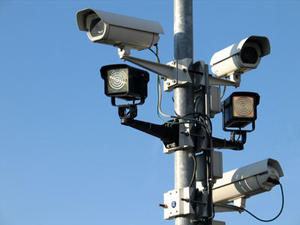SurveillanceStudy shows surveillance cameras reduce crime, in some cases
Published 26 September 2011
A recent study found that security cameras in urban areas have had mixed results in preventing crime; the study aimed to determine whether installing surveillance cameras to reduce crime is an effective use of scarce resources, especially with states struggling with soaring budget deficits and police departments facing steep cuts; the study found that the efficacy of cameras varies and is largely dependent upon how the surveillance system is set up and monitored

Surveillance camera array // Source: howtovanish.com
A recent study found that security cameras in urban areas have had mixed results in preventing crime.
The report, published by the Urban Institute, examined crime rates in Baltimore, Chicago, and Washington, D.C. to determine whether installing surveillance cameras to reduce crime is an effective use of scarce resources, especially with states struggling with soaring budget deficits and police departments facing steep cuts.
The study concluded that the efficacy of cameras varies and is largely dependent upon how the surveillance system is set up and monitored.
“Our study is interesting because it suggests that cameras can have a very powerful impact on crime, and a cost beneficial one, but it also suggests cameras don’t work in all places and all contexts,” said Nancy La Vigne, the director of the Urban Institute and one of the report’s co-authors.
For instance, in Chicago, surveillance cameras proved highly effective in reducing crime in one neighborhood, but in a nearby area they proved to be of little help.
In August 2003, Chicago authorities installed cameras in Humboldt Park and West Garfield Park in highly conspicuous areas with flashing blue lights mounted on top.
Prior to the installation of cameras, Humboldt Park had experienced a brief spike in crime with nearly 500 reported incidents in a single month, but after the cameras were put in place, crime dropped 20 percent the following month and stayed low. In contrast, in West Garfield Park, which is in the same police district, crime rates remained the same.
In digging deeper, the report found that residents in West Garfield Park did not believe that police officers regularly monitored the cameras and therefore continued to commit crimes as if they were not there. In addition, Humboldt Park had a much higher concentration of cameras, which led to faster response times and the increased likelihood of disrupting crimes in progress.
Johnnie King, the owner of King’s Hardware in West Garfield Park, complained that even if crimes were caught on camera, police would be slow to respond because they were not actively monitoring the system.
“If you don’t pay attention or even know it, what good is having it out there?” he asked.
Even with the crime rate showing no change in West Garfield Park, the report concluded that the benefits of the surveillance system outweighed the costs.
Chicago had spent roughly $190,000 a month on its surveillance system in Humboldt Park and West Garfield Park, but by installing the cameras, the city saved roughly $815,000 on criminal justice costs as well as victims’ financial and emotional costs. The benefits in Humboldt Park alone were enough to make up for the cost of installing cameras in West Garfield Park as it saved the city $4.30 for every dollar it had spent on installing cameras from the number of crimes it had prevented.
Based on its analysis, the report found that surveillance cameras can deter crime and are cost-effective, but only when they are properly monitored and installed.
“Overall, the cameras—when actively monitored—were effective at cutting down crime. And the savings and benefits of fewer crimes outweighed the cost of the surveillance system.”
To maximize the efficacy of cameras, the report recommended that authorities involve the community to ensure that they understand why the cameras are being put in place and to minimize objections, prioritize training for detectives and prosecutors to know how to properly use surveillance footage in cases, and to ensure that cameras feeds are actively monitored.
As a whole the report concluded that surveillance cameras are a useful law enforcement tool and can assist in preventing crimes, but are not a panacea by any means.
More Stories:
